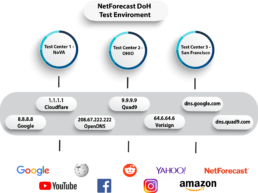NetForecast Report Finds DNS-over-HTTPS Lookup Times Increase by up to 510%
NetForecast Tests Highlight Significant Quality of Experience Degradation for Internet Browsing with DNS-over-HTTPS
October 10, 2019 – Reston, Virginia – NetForecast Inc. (“NetForecast”), an independent provider of broadband performance and internet usage accuracy solutions, has released the findings of its research report into the Quality of Experience that Internet Browsers will encounter when using DNS-over-HTTPs (DoH), the emerging protocol that was created to provide a more secure alternative for browsers, compared to conventional Domain Naming System (DNS).
The DNS acts as the ‘phone book’ of the Internet, translating domain names to IP addresses. In October 2018, the IETF (Internet Engineering Task Force) formally adopted the DoH protocol in order to provide an additional layer of security to protect users’ private information. However, in new performance tests conducted by NetForecast, the new protocol may create performance issues for users.
Utilizing NetForecast’s DoH test environment, the provider of broadband performance solutions tested the round-trip times for accessing and navigating popular websites including: NetForecast, Google, YouTube, Facebook, Wikipedia, Reddit, Amazon, Yahoo, and Instagram. Over seven days, more than 175,000 measurements were taken from three test servers located across different regions of the U.S. NetForecast’s preliminary findings included:
- Lookup times dramatically increase with DoH: The initial test results show that DoH lookup times are longer than DNS lookup times. On average, a DoH lookup time was 92.2ms, adding approximately 77ms when compared to the average DNS lookup time of 15.1ms.
- Lookup times increase on applications that require multiple lookups: Longer lookup times will have the most notable adverse effect on users of applications that require many lookups, such as social media, news feeds and e-commerce sites.
- User location and content destination impact DoH performance: The tests found that DoH performance varies, based on the region in which the user is located, as well as the location of destination content server.
- DoH and DNS lookup times vary over time: While both DoH and DNS lookup times vary over time, the variations with DoH were less pronounced. Because both lookup times vary over time, ISPs should continuously monitor their performance to manage the user experience.
Rich Evans, NetForecast CEO, commented:
“As the adoption of DoH increases, the degradation of the user experience will increasingly frustrate customers. In order for Network Service Providers and website owners to measure user quality in a DoH era, they should establish an initial baseline with DNS, then monitor and manage DoH performance continuously to better gauge its impact. As new technologies and architectures are deployed, CSPs need a way to safeguard their business by having the real-time QoE tools in place to detect problems when they arise.”
The NetForecast Quality of Experience solution suite enables service providers of broadband, mobile, WiFi, or satellite services to provide continuous, documented proof of service quality from an independent, trusted leader in internet service validation. NetForecast’s Quality of Experience suite utilizes more than 450 probes across the US to measure the latency and DNS lookup times required to detect issues affecting customer quality-of-experience in real time. To read NetForecast’s full report ‘DNS-over-HTTPS: How Does it Affect User Quality of Experience’, which includes the methodology and detailed results, download it here.

